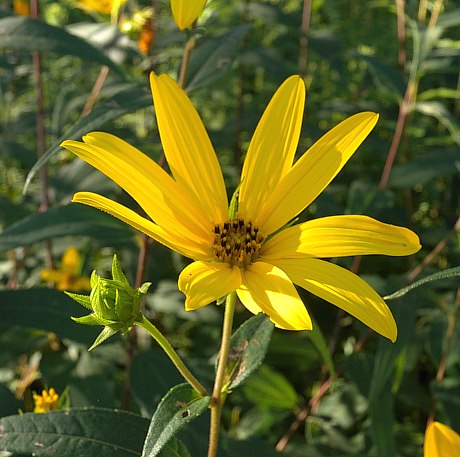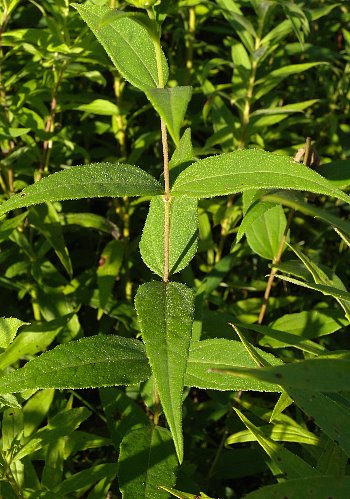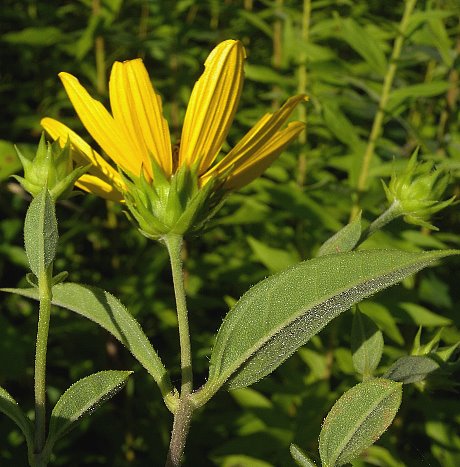
The central stem and any lateral stems terminate in flowerheads on erect to ascending peduncles (flowering stalks) about 1-4" long. These peduncles have characteristics that are similar to the central stem. Individual flowerheads are 2-3" across, consisting of 10-15 ray florets that surround numerous disk florets. The ray florets have petal-like corollas that are yellow; they are sterile. The disk florets have yellow tubular corollas that are perfect and fertile; they are 5-lobed along their upper rims. Around the base of each flowerhead, there are light green phyllaries (floral bracts) in 3-4 overlapping series; they are narrowly lanceolate to lanceolate in shape and slightly ciliate. When the flowerheads bloom, the phyllaries are ascending to widely spreading. The blooming period occurs from mid-summer to early fall for about 2 months. Afterwards, the disk florets are replaced by achenes about 4 mm. long that are narrowly ovoid, somewhat flattened, and glabrous (hairless). Each achene has a pair of tiny chaffy scales at its apex that become detached easily. The root system is fibrous and long-rhizomatous. This wildflower often forms colonies of plants from the rhizomes.
Cultivation: The preference is full or partial sun, mesic to dry conditions, and soil that contains clay-loam, loam, rocky material, or sand. Hairy Sunflower is easy to grow, but it may spread aggressively in some situations.
Range & Habitat: The native Hairy Sunflower is occasional throughout Illinois. Habitats include thinly wooded bluffs, upland savannas, borders of upland woodlands, black soil prairies, sand prairies, limestone glades, areas along railroads, and abandoned fields. In upland areas with woody vegetation, this wildflower is often associated with oak trees. It is found in both disturbed and higher quality habitats.
Faunal Associations: The nectar and pollen of Hairy Sunflower and other sunflowers attract a wide variety of insects, including long-tongued bees (honeybees, bumblebees, leaf-cutting bees, miner bees, cuckoo bees), short-tongued bees (Halictid bees & Andrenid bees), miscellaneous wasps, flies (Syrphid flies, bee flies, thick-headed flies, & others), butterflies and skippers, and occasional beetles. Several bees are specialist pollinators (oligoleges) of sunflowers: Andrena accepta, Andrena aliciae, Andrena helianthi, Dufourea marginatus, Melissodes agilis, and Pseudopanurgus rugosus. Other insects feed more destructively on the leaves, stems, flowerheads, plant juices, or roots. These species include caterpillars of the butterflies Chlosyne gorgone (Gorgon Checkerspot), Chlosyne nycteis (Silvery Checkerspot), and Vanessa cardui (Painted Lady); they also include caterpillars of the moths Dichomeris flavocostella (Cream-Bordered Dichomeris), Ogdoconta cinereola (Common Pinkband), and others. Additional insect feeders include Aphis helianthi (Sunflower Aphid) and other aphids, several treehoppers and leafhoppers, Clastoptera xanthocephala (Sunflower Spittlebug), the plant bugs Ilnacora stalii and Plagiognathus nigronitens, the thrips Heterothrips auranticornis, the larvae of Apion occidentale (Black Sunflower Stem Weevil) and other weevils, the leaf beetles Exema dispar and Sumitrosis inaequalis, Euphoria inda (Bumble Flower Beetle), the larvae of Contarinia schulzi (Sunflower Midge), and several grasshoppers (see the Insect Table for a more complete list of species).

The nutritious seeds of Hairy Sunflower and other sunflowers are eaten by the Bobwhite, Mourning Dove, Eastern Goldfinch, Tufted Titmouse, Harris Sparrow, White-Throated Sparrow, and other birds. The seeds are also eaten by some mammals, including the Gray Squirrel, Thirteen-Lined Ground Squirrel, Prairie Vole, and White-Footed Mouse. The Plains Pocket Gopher eats the rhizomes of sunflowers, while the White-Tailed Deer, Cottontail Rabbit, and Groundhog feed on the foliage. Because sunflowers are tall leafy plants that often form colonies, they provide good ground cover for many kinds of wildlife.
Photographic Location: A wildflower garden at Crystal Lake Park in Urbana, Illinois. The photographed plant is Helianthus hirsutus trachyphyllus.

Comments: Because Hairy Sunflower is rather variable across local populations in Illinois and elsewhere, three different varieties have been described: the typical variety, var. trachyphyllus, and var. stenophyllus. The typical variety has long bristly hairs along its stems and its leaves are usually 1-2½" across; var. trachyphyllus has short stiff hairs along its stems and its leaves are usually 1-2½" across; and var. stenophyllus has leaves that are only ½-1" across. The distribution map of Hairy Sunflower does not distinguish between these different varieties. Other sunflower species that Hairy Sunflower can be confused with include Helianthus pauciflorus (Prairie Sunflower), Helianthus strumosus (Pale-Leaved Sunflower), and Helianthus tuberosus (Jerusalem Artichoke). Prairie Sunflower resembles the narrow-leaved variety of Hairy Sunflower (Helianthus hirsutus stenophyllus), but its disk florets are dark purple or maroon, rather than yellow; Prairie Sunflower also has wider phyllaries (floral bracts) that are deltate-ovate in shape. Pale-Leaved Sunflower differs from Hairy Sunflower by its smooth (or nearly smooth) stems and its tends to have slightly longer petioles (½-1" long); also the undersides of its leaf blades are less hairy than those of Hairy Sunflower. The Jerusalem Artichoke differs by having slightly wider leaves with longer petioles (1-2½" long); it also has more alternate leaves along its stems. There is no dominant common name for Helianthus hirsutus. In addition to Hairy Sunflower, this species is also referred to as the Bristly Sunflower, Rough Sunflower, Oblong Sunflower, and Stiff-Haired Sunflower!